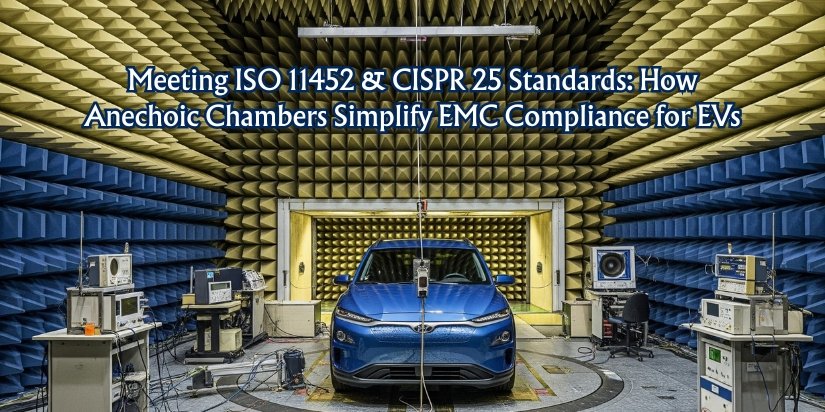As electric vehicles (EVs) surge in popularity, manufacturers face a new frontier of challenges—ensuring Electromagnetic Compatibility (EMC) in increasingly complex electronic ecosystems. Compliance with internationally recognized EMC standards, such as ISO 11452 and CISPR 25, is no longer optional but a core requirement for automotive safety, performance, and market approval. One of the most critical tools in this process is the anechoic chamber, a controlled environment designed specifically for accurate electromagnetic testing.
In this blog, we’ll break down why EMC compliance is essential for EVs, what ISO 11452 and CISPR 25 mean, and how anechoic chambers simplify the path to certification and performance optimization.
Why EMC Compliance Matters in EVs
Electromagnetic compatibility ensures that a vehicle’s electronic systems don’t interfere with one another or are disrupted by external electromagnetic signals. With EVs now equipped with advanced features such as autonomous driving sensors, vehicle-to-everything (V2X) communication, radar, GPS, LiDAR, and infotainment systems, EMC compliance has become a non-negotiable requirement.
Failure to comply can result in:
- Malfunctioning of safety-critical systems
- Reduced vehicle range and performance
- Regulatory non-compliance and product recalls
- Poor user experience
Hence, rigorous EMC testing is vital to build confidence in both the reliability and safety of modern electric vehicles.

Meeting ISO 11452 & CISPR 25 Standards
Understanding ISO 11452 and CISPR 25
ISO 11452: Road Vehicles — Component Test Methods for Electrical Disturbances
ISO 11452 is a series of international standards that specifies testing methods for assessing the immunity of electronic components to electrical disturbances caused by narrowband radiated electromagnetic energy.
There are various parts to ISO 11452, including:
- ISO 11452-2: Absorber-lined shielded enclosure method (commonly performed in anechoic chambers)
- ISO 11452-4: Bulk current injection (BCI)
- ISO 11452-5: Stripline method
Each method defines how components should be tested to ensure they remain unaffected by electromagnetic fields they may be exposed during real-world operations.
CISPR 25: Radio Disturbance Characteristics — Limits and Methods of Measurement
CISPR 25 is another globally adopted standard focusing on emissions, measuring the electromagnetic noise that components or systems radiate. It helps evaluate whether an EV’s onboard electronics disturb radio reception inside or outside the vehicle.
CISPR 25 defines various frequency bands, measurement setups, and limit levels for:
- Conducted emissions
- Radiated emissions
- Component-level and system-level testing
This standard is especially critical in EVs because electric drivetrains and high-voltage batteries can become significant sources of electromagnetic interference.
The Role of Anechoic Chambers in Meeting These Standards
Anechoic chambers are specialized, shielded rooms lined with RF-absorbing materials that eliminate external noise and prevent internal reflections. This controlled environment is crucial for both emission and immunity testing as required by ISO 11452 and CISPR 25.
Key Benefits:
Controlled Testing Environment
- Anechoic chambers provide a noise-free zone, simulating real-world RF scenarios without external interference. This helps in accurately measuring the performance of EV components.
Compliance with Global Standards
- Chambers are designed to meet the exact requirements for standards like ISO 11452-2 and CISPR 25, ensuring that test results are acceptable for regulatory submissions worldwide.
Efficient Troubleshooting
- Engineers can isolate problematic components or wiring easily, test modifications quickly, and retest under the same conditions, saving time and money.
Component and Full-Vehicle Testing
- From small ECUs to entire EVs, anechoic chambers can be scaled for both component-level and full-vehicle testing, covering every compliance need.
Future-Proofing for EV Innovation
- As vehicle technologies evolve, especially with the integration of 5G and V2X communications, anechoic chambers remain a scalable solution for advanced EMC validation.
Real-World Impact: From Compliance to Competitive Edge
Meeting EMC standards is not just a regulatory checkbox. It directly affects vehicle performance, consumer trust, and brand reputation. For example:
- An EV that suffers from GPS dropouts or poor mobile connectivity may lose its appeal in tech-savvy markets.
- Autonomous features heavily rely on uninterrupted sensor performance, which can be compromised by poor EMC design.
- Early-stage EMC testing in anechoic chambers can prevent costly redesigns and delays in certification later.
Electric vehicles symbolize the future of mobility—but they also bring complex EMC challenges to the forefront. As international standards like ISO 11452 and CISPR 25 set the benchmark for safety and reliability, anechoic chambers are proving to be indispensable in achieving these goals.
By offering a precise, controlled testing environment, anechoic chambers simplify EMC compliance, enhance product development efficiency, and help EV manufacturers bring smarter, safer, and globally compliant vehicles to market faster.

